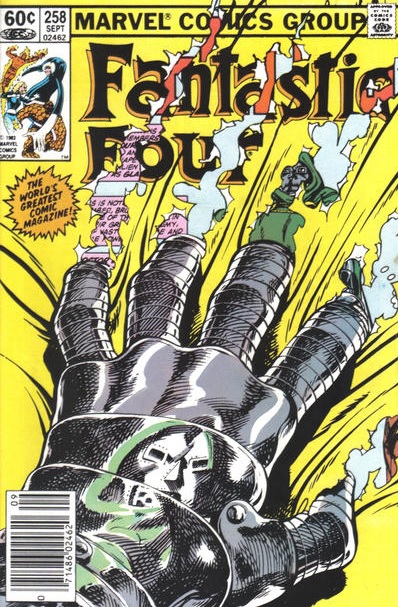
Up until 1983, the vast majority of the comics I read were back issues or bundled remainders picked up via flea markets or in polybagged three-packs sold at the supermarket checkout aisle. The few new releases that filtered down to me were wild card outliers passed on as gifts or picked up in trades with some incredibly fortunate friend whose out-of-state grandparents happened to live right next to a fully stocked funnybook shop.
Occasionally some almost-new release would turn up in amidst the Ford Era quarter bin overstock — typically some newsprinted proof that the “New DC” wasn’t as unstoppable as advertised — but otherwise my childhood comics fandom involved resigning myself to reading catch-as-catch-can fragments from yesteryear. It affected my tastes and my buying habits. Uncertainty about ever getting to read the conclusion of a multi-issue story meant that I picked up stuff that gave the most bang for my fourth-of-a-buck — guest appearances, giant-size issues, team-ups, or any other cover-level hook that promised to mitigate the frustration of getting stuck with a cliffhanger ending.

That situation began to change in 1983, when my buddy Brian discovered that a local newsvendor had a spinner rack stocked with current funnybook releases. The “local” was somewhat relative, as the place was in the heart of Woburn Center and a good two miles away from the neighborhood where we lived. Getting there as an eleven year old was a major expedition, one that involved a long-ass bike ride and a good deal of deception aimed at disapproving parental units. (My parents were less strict than most, but even they weren’t thrilled with the idea of their eldest crossing the nightmarish Route 128/38 rotary to buy a ‘fucking SU-PER-MAN comic.”)
Brian and I did it, though. Not regularly, but happily. This was also the first time when I had a leg up over my friendly rival on the collecting front. My maternal grandparents lived only a half-dozen blocks from the newsvendor, and the Saturdays I spent at their duplex meant more opportunities to pick up the good shit before Brian could. What I didn’t want could then be used as leverage in trades for stuff of his that I did covet.

While the newsstand was a mostly reliable place to acquire new releases, it didn’t stock double-sized issues or annuals for some reason. Those had to be scored either through the trading grapevine or from the neckbearded dude who used to sell polybagged recent back issues during one of the frequent “collector shows” hosted by the Woburn Mall. It was from him that I picked up the epic finale of the X-Men‘s “Brood Saga” (gorgeously illustrated by Paul Smith) and the tail end of the original Official Handbook of the Marvel Universe‘s run. I devoured both with rapt adoration that would deeply affect my fandom in the years to come.

Even with these increased levels of consumer access, my buying habits hewed closely to those of the guest-star-and-novelty-driven ones of the flea market days. Getting excited about an Air Wave appearance might be a difficult to wrap one’s head around, but it was something new and different to a kid with little knowledge of the cynically speculative side of the industry. After all, why would they team Air Wave up with SUPERMAN if DC didn’t have confidence in the character’s star power? (Yes, I know the question answers itself, but that realization wouldn’t come for another few years and many painful experiences.)
There was a 1983 debut that grabbed me enough that it became the first series I followed from the start and the first series I followed on a regular basis, full stop —

— the New Mutants.
The teen mutant melodrama was a big deal at the time, being the first ongoing spinoff from the speculator-and-fan-favorite X-Men series. As befitting a “big event,” the team made their debut in a prestige format graphic novel. I was given a copy of it (which a still own as loose pages gathered in a tatted cover) as an eleventh birthday gift by my uncle. He also gave me a copy of the first issue of the 1982 Wolverine miniseries signed “All the best, Andy!” by Chris Claremont himself, but it couldn’t top the oversized intro of “the next generation of Marvel mutants.”
The concept hooked me on multiple levels. From a collector’s standpoint, there was something compelling about getting in on the ground floor of what was pitched as the next big thing. From the perspective of a kid hitting the cusp of adolescence, the on-the-nose allegory between pubescent angst and mutant melodrama resonated on a deeply personal level. It was in the same vein as the early Spider-Man stories, but Claremont brought a bit more sensitivity and verisimilitude to the subject matter than Stan the Man could ever muster…while Bob McLeod’s art was more in synch with contemporary teendom than Ditko’s style ever was. (It’s not an absolute question of “who is better,” but rather one of “who was better for that particular moment.”)
And I’m not going to lie — I had a massive crush on Wolfsbane.
After finding the first issue of the ongoing on the spinner rack, I made a dedicated effort to keep up with the series, right down to memorizing the release dates and planning my trips to the shop accordingly. I managed to keep up with it (with a few missed issues) right on up though the bizarre Bill Sienkiewicz run, which I wasn’t crazy about at the time but have since grown to appreciate.
As I got in the habit of following a current series on a regular basis, I started to follow other series as well in the months that followed. All-Star Squadron was a early add, alongside Atari Force, Justice League, and Iron Man. Around the same time, CVS and the Christy’s chain of convenience stores started adding comics to their magazine aisles, making it even easier to keep up with old favorites and try out new (Big Two) things.
By the time I discovered a full-fledged direct market shop within biking distance in late 1984, the new phase of my comics was already in full swing.
1983 is where it began, though, and it continues to color the material for me in odd way to the present day. I’ve collected complete runs around many of the isolated single issues I read back in those days. Whenever I read them en masse, those later purchases are “just comics” to me. The ads and references might elicit small flashes of nostalgia, but the comics are just parts of a narrative stream — until I get to one of the issues I owned back in the day, at which point I get hit with a multimegaton blast of Proustian melancholy. It completely transforms my reading experience, turning dormant memories into lucid flashbacks for eighteen to twenty-two pages. Then it’s back to business as usual.
I guess what I’m saying is that Starfox joining the Avengers is my own personal “episode of the madeleine.”


July 14th, 2016 - 5:17 pm
I’ve read that the things you encounter at age 12 stick with you forever, and that definitely holds true for me and the comics of that era. I owned every title pictured, and bought most of what you mention.
I’ve often felt that the best teen hero comics make the reader wish he/she was him/herself a member of the team, hanging out with those characters. And, yes, that involves forming a crush on someone on the team. I think for most comic nerds it was Wolfsbane, although I had a fondness for Magik, as well, when she joined. And when Cipher joined, it became the perfect title for a teenage comic reader to project themselves into, because they actually had a normal, awkward guy on the roster.
My friends and I mocked the Sienkiewicz issues as well. I knew people who absolutely hated it. I remember thinking it was fine for the Demon Bear story, but felt like an odd fit on a monthly basis. I think I still feel that way a little. He’s undoubtedly talented, and perfect for certain projects, but for a monthly Marvel title in the 1980s, it was pretty jarring.
July 16th, 2016 - 4:27 pm
In the ’80s, I totally bought into 50/60s nostalgia and longed to have been a part of that time period, without really factoring in all the racism, sexism, lame media, pathetic technology, and the overall dread filled ignorance. As I get older, I kind of still wish I’d come up in the pre-AIDS era of hedonism. That said, most of the same drawbacks apply, plus the music was worse, the economy sucked, and I’d have to live through the ’80s again as a burnout with herpes and a trail of latchkey bastards. So not only have I made peace with my lot in life, but I’ve become the thing I hated, a time-shifted Baby Boomer mythologizing the summer of ’86. I bought that DC Comics Presents featuring Air Wave and Parasite at 7-11 with pocket change left over from picking up my grandmother’s pack of Virginia Slims after crossing through sewage draining out of that one spot on the sidewalk for the thousandth time. I shopped at that flea market with the clear plastic grab bags of secondhand pop ephemera while The Making of Thriller played on a rare early VHS. I listened to the same oldies and A.M. country my family did until adolescent angst sent me down the dial for my own music. I catch a snippet of Air Supply and I’m back lying on the bedroom floor with my stepsisters watching Friday Night Wrestling on a black & white TV. I’m right here with you, brother.
July 17th, 2016 - 12:28 am
That was a sweet story…
And yah, there’s thousands of guys out there who will go back to the 80s when they die. It will be jean jackets, Converse hi-tops, and T-top Camaros for the rest of time, and the cyberpunk future will always be just around the corner…